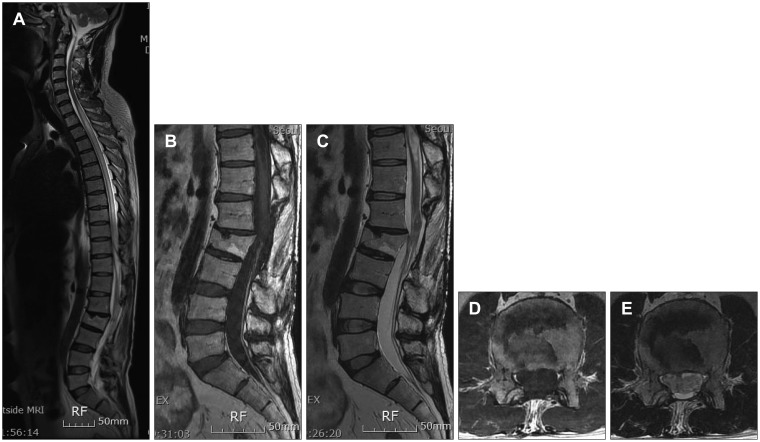Korean J Neurotrauma.
2014 Oct;10(2):66-69. 10.13004/kjnt.2014.10.2.66.
Clinical Features of Post-Traumatic Syringomyelia
- Affiliations
-
- 1Department of Neurosurgery, VHS Medical Center, Seoul, Korea. spineho@naver.com
- KMID: 2256233
- DOI: http://doi.org/10.13004/kjnt.2014.10.2.66
Abstract
OBJECTIVE
The purpose of this study was to analyze the clinical manifestations, radiological findings, treatment results, and clinical significance of post-traumatic syringomyelia (PTS).
METHODS
We retrospectively reviewed the medical charts of nine surgical patients with symptomatic PTS between 1992 and 2012.
RESULTS
The most common clinical manifestation was development of new motor weakness. The mean interval between the initial injury and the onset of new symptoms 21.9 years. The mean length of the syringes observed on preoperative magnetic resonance images was 7.8 spinal levels. Shunting procedures were performed in five patients. Four patients underwent arachnoidolysis and duraplasty. Patients developed mechanical shunt failure. Postoperatively, one patient showed clinical improvement, four patients were stable, and four patients showed deterioration.
CONCLUSION
PTS is a disabling sequelae of spinal cord injury, which develops months to years after spinal injury. We have to consider that patients with PTS may have poor long-term outcome.
Figure
Reference
-
1. Batzdorf U, Klekamp J, Johnson JP. A critical appraisal of syrinx cavity shunting procedures. J Neurosurg. 1998; 89:382–388. PMID: 9724111.
Article2. Carroll AM, Brackenridge P. Post-traumatic syringomyelia: a review of the cases presenting in a regional spinal injuries unit in the north east of England over a 5-year period. Spine (Phila Pa 1976). 2005; 30:1206–1210. PMID: 15897837.3. Edgar R, Quail P. Progressive post-traumatic cystic and non-cystic myelopathy. Br J Neurosurg. 1994; 8:7–22. PMID: 8011197.
Article4. el Masry WS, Biyani A. Incidence, management, and outcome of post-traumatic syringomyelia. In memory of Mr Bernard Williams. J Neurol Neurosurg Psychiatry. 1996; 60:141–146. PMID: 8708641.
Article5. Hida K, Iwasaki Y, Imamura H, Abe H. Posttraumatic syringomyelia: its characteristic magnetic resonance imaging findings and surgical management. Neurosurgery. 1994; 35:886–891. discussion 891. PMID: 7838337.6. Kaynar MY, Koçer N, Gençosmanoğlu BE, Hanci M. Syringomyelia--as a late complication of tuberculous meningitis. Acta Neurochir (Wien). 2000; 142:935–938. discussion 938-939. PMID: 11086834.7. Klekamp J, Batzdorf U, Samii M, Bothe HW. Treatment of syringomyelia associated with arachnoid scarring caused by arachnoiditis or trauma. J Neurosurg. 1997; 86:233–240. PMID: 9010425.
Article8. Parziale JR, Frates EP. Dyspnea: an unusual presentation of posttraumatic syringomyelia. Am J Phys Med Rehabil. 2006; 85:185–186. PMID: 16428913.
Article9. Perrouin-Verbe B, Lenne-Aurier K, Robert R, Auffray-Calvier E, Richard I, Mauduyt de la Grève I, et al. Post-traumatic syringomyelia and post-traumatic spinal canal stenosis: a direct relationship: review of 75 patients with a spinal cord injury. Spinal Cord. 1998; 36:137–143. PMID: 9495005.
Article10. Quencer RM, Green BA, Eismont FJ. Posttraumatic spinal cord cysts: clinical features and characterization with metrizamide computed tomography. Radiology. 1983; 146:415–423. PMID: 6849087.
Article11. Sgouros S, Williams B. A critical appraisal of drainage in syringomyelia. J Neurosurg. 1995; 82:1–10. PMID: 7815110.
Article12. Sgouros S, Williams B. Management and outcome of posttraumatic syringomyelia. J Neurosurg. 1996; 85:197–205. PMID: 8755746.
Article13. Umbach I, Heilporn A. Review article: post-spinal cord injury syringomyelia. Paraplegia. 1991; 29:219–221. PMID: 1870887.
- Full Text Links
- Actions
-
Cited
- CITED
-
- Close
- Share
- Similar articles
-
- A Case of Post-Traumatic Syringomyelia Extending from the Foramen Magnum to the Conus Medullaris
- Post-Traumatic Syringomyelia Treated with Expansile Duraplasty and Syringosubarachnoid Shunt : Case Report
- Syringomyelia in the Tethered Spinal Cords
- Pathologic Findings of Experimental Post-traumatic Syringomyelia
- Intramedullary Spinal Hemangioblastoma Associated with Syringomyelia


